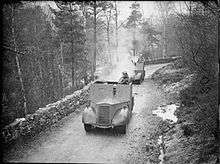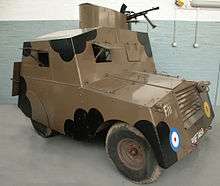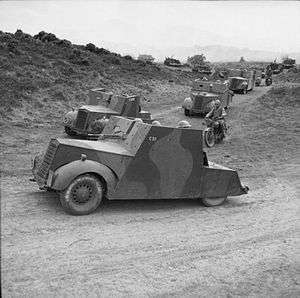Standard Beaverette
| Standard Car 4x2 | |
|---|---|
|
Beaverettes of 53rd Reconnaissance Regiment on manoeuvres in Northern Ireland, 1941 | |
| Type | Armoured car |
| Place of origin |
|
| Production history | |
| Manufacturer | Standard Motor Company |
| Specifications | |
| Weight |
Mk I: 2 tonnes (2.2 short tons; 2.0 long tons) Mk III: 2.6 tonnes (2.9 short tons; 2.6 long tons) |
| Length |
Mk I: 4.11 m (13 ft 6 in) Mk III: 3.10 m (10 ft 2 in) |
| Width |
Mk I: 1.60 m (5 ft 3 in) Mk III: 1.73 m (5 ft 8 in) |
| Height |
Mk I: 1.52 m (5 ft 0 in) Mk III: 2.16 m (7 ft 1 in) |
| Crew | 3 |
|
| |
| Armour |
Mk III: up to 9 mm (0.35 in) Mk IV: up to 12 mm (0.47 in) |
Main armament | 0.303 (7.7 mm) Bren MG or twin Vickers machine gun |
| Engine |
Standard 4-cylinder petrol engine 46 hp (34 kW) |
| Power/weight | 17-23 hp/tonne |
| Suspension | 4x2 wheel, leaf spring |
Operational range | Mk III: 300 km (190 mi) |
| Speed | Mk III: 38 km/h (24 mph) |
Standard Car 4x2, or Car Armoured Light Standard, better known as the Beaverette, was a British armoured car produced during World War II.
History
The first version of the vehicle was built in 1940 by Standard Motor Company at the instigation of Lord Beaverbrook, then Minister of Aircraft Production (hence the name Beaverette). It was based on commercial car chassis, on which a simple riveted armoured hull was mounted. The 11mm of steel was backed by 3 inch thick oak planks.[1] The hull was open at the top and at the rear. The armament consisted of a Bren light machine gun which could be fired through a slot in the glacis armour. Subsequent versions received all-around protection and a machine gun turret - an enclosed one with Bren MG or an open-topped one with twin Vickers machine guns. Some vehicles also carried Boys anti-tank rifles. Some also had a No. 11 or No. 19 radio set. Production was stopped in 1942. About 2,800 units were delivered.
The Beaverette was used by the British Army and RAF Regiment for home defence service and training. The vehicle is said to have suffered from excessive weight and to have been hard to handle.

Variants
- Mk I - original version.
- Mk II - had all-around armour and the radiator grill was moved from a vertical position to a horizontal one.[1]
- Mk III Beaverbug - had shortened chassis, redesigned hull without curved front wings, with top armour and a machine gun turret. A Mk III was used by the RAF Regiment in the capture of a FW 190 and destruction of another when they landed at RAF West Malling in April 1943.[2]
- Mk IV - glacis armour was redesigned to improve visibility.
- A similar vehicle, known as Beaverette (NZ), was produced in New Zealand Railways workshops, Hutt Valley. The car used a Ford 3/4 or 1-ton truck chassis and plate salvaged from the ships Port Bowen and Mokoia for armour. They had a crew of 4 and 208 units were built.[3]
Survivors
A Mark III Beaverette is displayed at the Imperial War Museum Duxford. Another Mark III is in the Cobbaton Combat Collection, a private collection of military vehicles in Umberleigh, Devon in the United Kingdom[4] A Mark IV Beaverette is displayed at the Museum Bevrijding Vleugels in the Netherlands. A second Mark IV is preserved at The Curragh Military Museum in Ireland.
References

- Citations
- 1 2 Livesey, Jack (2007). Armoured Fighting Vehicles of Would Wars I and II. Southwater. p. 36. ISBN 978-1-84476-370-2.
- ↑ Oliver, Kingsley. The RAF Regiment at War 1942-1946. Pen & Sword.
- ↑ Richard Stowers - Waikato Troopers, Richard Stowers 2008, ISBN 978-0-473-13146-3
- ↑ "Cobbaton Combat Collection". Cobbaton Combat Collection. Retrieved 26 February 2016.
- Bibliography
- George Forty - World War Two Armoured Fighting Vehicles and Self-Propelled Artillery, Osprey Publishing 1996, ISBN 978-1-85532-582-1.
- I. Moschanskiy - Armored vehicles of the Great Britain 1939-1945 part 2, Modelist-Konstruktor, Bronekollektsiya 1999-02 (И. Мощанский - Бронетанковая техника Великобритании 1939-1945 часть 2, Моделист-Конструктор, Бронеколлекция 1999-02).
External links
| Wikimedia Commons has media related to Standard Beaverette. |
